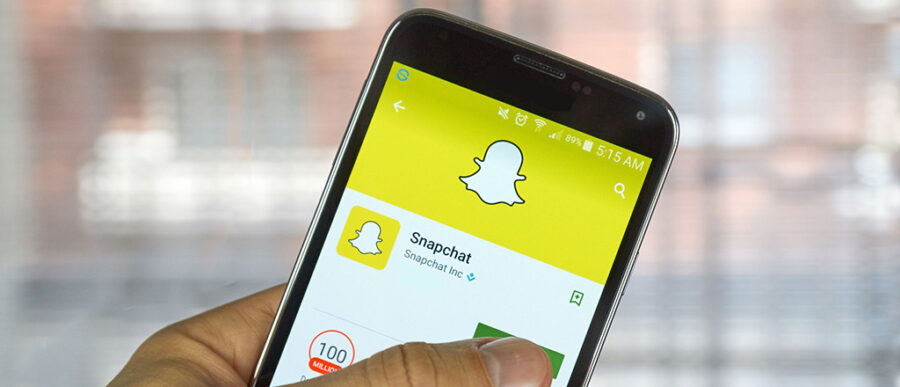When Snapchat CEO Evan Spiegel walked away from a $3 billion buyout offer from Facebook three years ago, the move shocked many observers who couldn’t believe a small, unprofitable startup could be so bold. But that bet is poised to pay off. Snapchat, a camera and ephemeral messaging app favored by teens, is reportedly going public early next year with a valuation of at least $25 billion.
Those over 35 might not understand why a five-year-old app with silly features could be more attractive to investors than Twitter, which is having difficulty finding a buyer despite being an entrenched tech brand whose service is used by many heads of state. But Twitter is stumbling while Snapchat has stayed surprisingly resilient.
Since 2013, Snapchat’s U.S. audience has grown by nearly 76% compounded annually, according to an October report by Bloomberg Intelligence. It has an estimated 220 million to 250 million monthly active users, of whom up to 85% are ages 13 to 34. In contrast, Twitter reported a mere 3% increase in average monthly active users worldwide to 313 million in the second quarter from a year earlier, according to a U.S. Securities and Exchange Commission filing. This year, Snapchat’s daily active users has topped 150 million, surpassing Twitter, according to Bloomberg News.
But as it gets closer to an IPO, the issue before investors is this: Will Snapchat fall into the same slower growth trap as Twitter?
Wharton marketing professor Ron Berman says the answer lies in how Snapchat plans to pivot. “The strategic question in my opinion is whether Snapchat is closer to Twitter or to Facebook in usage and user perception. By becoming closer to Facebook with richer content and properly integrating commercial and private content, Snapchat may become a substitute for Facebook and this way be able to monetize its platform.”
Data is the name of the game. Facebook has deep troves of information about its users beyond age and gender. It knows a user’s likes, hobbies, family relationships and many other data points. Not so with Twitter. “Twitter’s monetization challenge has been data. Unlike Facebook, Twitter doesn’t have as much data on user demographics, preferences, or likes and dislikes,” says Jonah Berger, a Wharton marketing professor. And Snapchat has the same problem as Twitter. “Sure, they have traffic, but without knowing that much about their users, it becomes harder to serve them targeted ads, and as a result, harder to make money,” he adds.
Spiegel’s answer is to deepen user engagement on Snapchat by adding more fun features as well as news and other content. For example, it offers users “geofilters” to overlay on their photos or snaps: A Philadelphia user could layer on a University of Pennsylvania moniker. Another popular feature is the ability to swap faces with friends. Snapchatters can also pop “lenses” on selfies to make themselves look like puppy dogs or bumble bees.
“By becoming closer to Facebook with richer content and properly integrating commercial and private content, Snapchat may become a substitute for Facebook.” –Ron Berman
As for content, the company has unveiled a feature similar to Facebook’s News Feed called “Stories,” where users can compile different experiences. Stories and snaps are filed into albums called “Memories.” “Live Stories” lets individuals at the same event contribute to a flow of experiences. Meanwhile, a new “Discover” section features articles from CNN, Buzzfeed and other publishers. And it is in talks to develop “Snapchat Shows” video series, according to Recode. Ads are inserted in these new services.
Snapchat’s business has been growing fast. For this year, it is projecting revenues between $250 million to $350 million, which would be an increase of as much as 500% from $59 million in 2015, according to TechCrunch. For 2017, the company is targeting $500 million to $1 billion. “Snapchat has done a great job monetizing its service so far” despite serving a young audience famous for being fickle, notes Kartik Hosanagar, Wharton professor of operations, information and decisions. “In addition to standard ads, they have done sponsored lenses that allow users to apply filters to their selfies.”
For instance, a Taco Bell-sponsored lens that turned users’ faces into talking tacos — complete with fiery eyebrows as the chain’s signature gong rings in the background — racked up 224 million views in one day. This type of alliance is an “excellent example of integrating the marketing seamlessly into the user experience. It doesn’t hurt user experience and also provides great value to advertisers,” Hosanagar says.
A survey by Variety released in March shows that Snapchat’s moves could be working: Nearly half of Snapchat users between ages 13 and 24 say they looked at Live Stories or Discover at least daily. Also, only 12% felt there were too many ads while about half said the ad load was “tolerable.”
On the back end, Snapchat has launched an ads API that makes it easier for marketers to buy advertising at scale, according to Advertising Age. Apart from ads, the app also is generating revenue by charging for services such as creating custom geofilters ($5 and up) and additional replays of snaps received (99 cents). Notably, it just unveiled a hi-tech hardware product: Spectacles. These are stylish eyeglasses with embedded cameras that take short videos for uploading to Snapchat via Wi-Fi or Bluetooth.
This thinking-outside-the-box hardware play impresses Wharton marketing professor Peter Fader. Compared to Twitter, “Snapchat has been bolder at doing these kinds of things … in the spirit of customer centricity,” he says. Also, unlike Twitter, Snapchat isn’t afraid to charge users where it can provide additional value. He believes people will get used to fees — much like folks have accepted LinkedIn’s premium service. “The more value-added things you surround yourself with, the less price-sensitive people become. Snapchat has shown the willingness to go there,” Fader notes.
“Snapchat has done a great job monetizing its service so far.” –Kartik Hosanagar
Indeed, Spiegel recently changed the company’s name to Snap Inc. in a signal that the company’s future lies beyond disappearing messages. “When we were just getting started, it made sense to name our company Snapchat Inc., because Snapchat was our only product!” he wrote in a September 2016 blog. “Now that we are developing other products, like Spectacles, we need a name that goes beyond just one product — but doesn’t lose the familiarity and fun of our team and board.”
Snap, the Platform
The bottom line is that while Twitter’s service has remained essentially the same, Snapchat has kept innovating to maintain its competitiveness, Fader says. The app’s rich $25 billion valuation “may reflect the possibility that what’s now an entertainment and video messaging service could become a portfolio app hosting various payment, e-commerce and communications functions that exceed its current capability,” Bloomberg Intelligence noted.
A clue to Snapchat’s reinvention can be found in its slate of acquisitions since 2014, the report said. These buyouts include Vurb, a mobile search app, Obvious Engineering, a 3-D photography company, Bitstrips, a personal emoji and comics maker, Looksery, a face-transformation services that is incorporated into Snapchat’s Lenses, Scan.me, a QR-code startup, Vergence Labs (which powers Spectacles) and video chat service AddLive.
As it grows, maintaining a focus on users will be critical. “Snapchat, or any service that collects textual data on customers, has the opportunity to use Natural Language Processing and sentiment analysis to understand the mind of the consumer,” says Eric Bradlow, Wharton marketing professor. Everything from photos stored to taste in music “can all be very strong signs of your ‘latent self’ and hence product preferences.”
Importantly, Snapchat is a real-time data source that can supplement transactional data to provide customer insights. “Then, the money starts to flow from advertising, product recommendations and the use of the data as an information source for companies,” Bradlow notes.
Wharton marketing professor Jerry (Yoram) Wind adds that Snapchat can avoid Twitter’s predicament by taking the following steps: redefining ads to make them more engaging by ensuring they are relevant and respectful, actionable, valuable, experientially exceptional and shareworthy (RAVES); leveraging its growing user base to become an engaged network around an evolving platform; making sure its content generation activities, together with user-generated content, create engaged communities that can develop additional revenue sources ranging from advertising to e-commerce.
“Everyone wants to capture young people’s eyeballs. As soon as something new comes out, those young folks will switch.” –Jonah Berger
As it develops engaged communities, Wind says, other revenue sources could emerge such as membership subscription fees and new sponsorships from brands. Snapchat could also add brands to its current media channel lineup. As the app generates valuable data about its users, correctly addressing privacy concerns can lead to more revenue generation centered around data analytics. Wind also points out that Snapchat currently caters mainly to U.S. users, and as such has plenty of growth opportunities abroad. “With the right innovative and courageous leadership, they have a high likelihood of achieving their and the stock market’s expectations.”
The Bear Case for Snapchat
But L&F Capital Management, a Facebook shareholder, lays out the bear case for Snapchat. In a recent opinion piece on Seeking Alpha, it said the app’s features are “easily replicated” and that Facebook-owned Instagram will eventually attract hordes of teens from Snapchat. After Instagram unveiled its own disappearing ‘Stories,’ it has grown to 60% the size of Snapchat in just two months to 100 million daily active users. “Snapchat will be a victim of Facebook’s app consolidation plans. Through replicating and improving Snapchat’s core features, Facebook will consolidate the user base and recapture the all-important youth demographic.”
However, Facebook did try to mimic Snapchat with its Poke disappearing content service to no avail, and then offered to buy the company. And there are signs its hold on the young is slipping: This month, Piper Jaffray released the results of a survey that shows Facebook engagement is decreasing among teens and it is losing ground to Snapchat and Instagram. But Facebook remains undaunted: It reportedly is testing a Snapchat Stories clone called Messenger Day, which also disappears in 24 hours, in Australia.
Looking ahead, Hosanagar says that Snapchat’s biggest challenge is to “stay relevant as the current generation of Snapchat users ages and a new generation comes on within five to 10 years.” Berger adds that while the app is “hot now, everyone wants to capture young people’s eyeballs. As soon as something new comes out, those young folks will switch.”
However, Berman notes that “the funny thing is that they said the same thing about Facebook 10 years ago, and since then, many of Facebook’s members have aged. When platforms have the ability to keep their users engaged and [the activity becomes] a second habit, we only expect the appeal to advertisers to increase as the consumer base ages. I think currently advertisers may still be experimenting with Snapchat, but over time they’ll grow more comfortable with advertising on the platform.”



